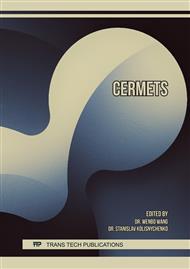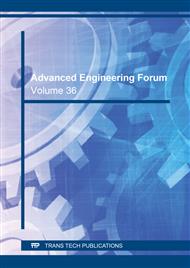[1]
A. Bhattacharya, S. Das, P. Majumder, A. Batish, Estimating the effect of cutting parameters on surface finish and power consumption during high speed machining of AISI 1045 steel using Taguchi design and ANOVA, Production Engineering : Research & Development, Vol. 3, (2009),31–40.
DOI: 10.1007/s11740-008-0132-2
Google Scholar
[2]
A. Çiçek, T. Kıvak, G. Samtaş, Application of Taguchi Method for Surface Roughness and Roundness Error in Drilling of AISI 316 Stainless Steel, Journal of Mechanical Engineering Vol. 58, (2012), 165-174.
DOI: 10.5545/sv-jme.2011.167
Google Scholar
[3]
M. Kaladhar, K. Venkata Subbaiah, Rao Ch. Srinivasa, Determination of optimum Process Parameters during turning of AISI 304 Austenitic stainless steels using Taguchi method and ANOVA, International Journal of lean thinking, Vol.1, (2012), 1-19.
DOI: 10.5267/j.ijiec.2012.04.002
Google Scholar
[4]
P. Marimuthu, K. Chandrasekaran, Machinability study on stainless steel and optimum setting of cutting parameters in turning process using Taguchi design of experiments. Int.J. Materials and Product Technology, Vol.43, (2012), 122–133.
DOI: 10.1504/ijmpt.2012.047648
Google Scholar
[5]
C. Camposeco-Negrete, Optimization of cutting parameters for minimizing energy consumption in turning of AISI 6061 T6 using Taguchi methodology and ANOVA, Journal of Cleaner Production, Vol. 66, (2013), 309-316.
DOI: 10.1016/j.jclepro.2013.03.049
Google Scholar
[6]
L. Bouzid, S. Boutabba, M.A. Yallese, S. Belhadi, F. Girardin, Simultaneous optimization of surface roughness and material removal rate for turning of X20Cr13 stainless steel, International Journal of Advanced Manufacturing Technology,Vol, 74, (2014), 879-891.
DOI: 10.1007/s00170-014-6043-9
Google Scholar
[7]
G. Kant, K.S. Sangwan, Prediction and optimization of machining parameters for minimizing power consumption and surface roughness in machining. Journal of Cleaner Production, Vol. 83, (2014), 151-164.
DOI: 10.1016/j.jclepro.2014.07.073
Google Scholar
[8]
T. Rajmohan, S.D. Sathishkumar, K. Palanikumar, S. Ranganathan, Modeling and analysis of cutting force in turning of AISI 316L Stainless Steel (SS) under nano cutting environment, Applied Mechanics and Materials, Vol. 766-767, (2015), 949-955.
DOI: 10.4028/www.scientific.net/amm.766-767.949
Google Scholar
[9]
R. Nur, M.Y. Noordin, S. Izman, D. Kurniawn, Machining parameters effect in dry turning of AISI 316L stainless steel using coated carbide tools, Journal of Process Mechanical Engineering, Vol. 231, (2017), 676-683.
DOI: 10.1177/0954408915624861
Google Scholar
[10]
A. Selaimia, M.A. Yallese, H. Bensouilah, I. Meddour, I. Khattabi, T. Mabrouki, Modeling and optimization in dry face milling of X2CrNi18-9 austenitic stainless steel using RMS and Desirability approach, Measurement, Vol. 107, (2017), 53-67.
DOI: 10.1016/j.measurement.2017.05.012
Google Scholar
[11]
S.A. Bagaber, A.R. Yousof, Multi objective optimisation of cutting parameters to minimise power consumption in dry turning of stainless steel 316, Journal of cleaner Production, Vol. 157, (2017),30-46.
DOI: 10.1016/j.jclepro.2017.03.231
Google Scholar
[12]
O. Zerti, M.A. Yallese, R. Khettabi, K. Chaoui, T. Mabrouki, Design optimization for minimum technological parameters when dry turning of AISI D3 steel using Taguchi method, International Journal of Advanced Manufacturing Technology, Vol. 89, (2017), 915-(1934).
DOI: 10.1007/s00170-016-9162-7
Google Scholar
[13]
L. Bouzid, S. Berkani, M.A. Yallese, F. Girardin, T. Mabrouki, Estimation and optimization of flank wear and tool lifespan in finish turning of AISI 304 stainless steel using desirability function approach, International Journal of Industrial Engineering Computations, Vol. 9, (2018), 349-368.
DOI: 10.5267/j.ijiec.2017.8.002
Google Scholar
[14]
A. Zerti, M.A. Yallese, I. Meddour, S. Belhadi, A. Haddad, T. Mabrouki, Modeling and multi-objective optimization for minimizing surface roughness, cutting force, power and maximizing productivity for tempered stainless steel AISI 420 in turning operations, International Journal of Advanced Manufacturing Technology, Vol. 102, (2019),135-157.
DOI: 10.1007/s00170-018-2984-8
Google Scholar
[15]
D.C. Montgomery, Design and Analysis of Experiments, 8nd ed, (2013), John Wiley & Sons, New York.
Google Scholar
[16]
M. Nouioua, M.A. Yallese, R. Khettabi, S. Belhadi, M. Bouhalais, F. Girardin, Investigation of the performance of the MQL, dry and wet turning by response surface methodology (RSM) and artificial neural network (ANN), International Journal of Advanced Manufacturing Technology, Vol. 93, (2017), 2485-2504.
DOI: 10.1007/s00170-017-0589-2
Google Scholar
[17]
S. Berkani, M.A. Yallese, L. Boulanouar , Statistical analysis of AISI304 austenitic stainless steel machining using Ti (C, N)/Al2O3/TiN CVD coated carbide tool, International Journal of Industrial Engineering Computations, Vol. 6, (2015), 539-552.
DOI: 10.5267/j.ijiec.2015.4.004
Google Scholar
[18]
M. Azam, M. Jahanzaib, A. Wasim, S. Hussain, Surface roughness modeling using RSM for HSLA steel by coated carbide tools, International Journal of Advanced Manufacturing Technology, Vol. 78, (2015), 1031-1041.
DOI: 10.1007/s00170-014-6707-5
Google Scholar
[19]
A. Bouziane, L. Boulanouar, M. Azizi, O. Keblouti, S. Belhadi, Analysis of cutting forces and roughness during hard turning of bearing steel, Structural Engineering and Mechanics, Vol. 66, (2018), 285-294.
DOI: 10.12989/sem.2017.61.4.519
Google Scholar
[20]
M. Mia, Mathematical modeling and optimization of MQL assisted end milling characterisitics based on RSM and Taguchi method, Measurement, Vol. 121, (2018), 249-260.
DOI: 10.1016/j.measurement.2018.02.017
Google Scholar
[21]
M.A. Yallese, K. Chaoui, N. Zeghib, L. Boulanour, J.F. Rigal, Hard machning of hardend bearing steel using cubic boron nitride tool, Journal of Materials Processing Technology, Vol. 209, (2009),1092-1104.
DOI: 10.1016/j.jmatprotec.2008.03.014
Google Scholar
[22]
A. Khellaf, H. Aouici, S. Smaiah, S. Boutabba, M.A. Yallese, M. Elbah, Comparative assessement of two ceramic cutting tools on surface roughness in hard turning of AISI H11 steel :including 2D and 3D surface topograghy, International Journal of Advanced Manufacturing Technology, Vol.89, (2017),333-354.
DOI: 10.1007/s00170-016-9077-3
Google Scholar
[23]
YS. Ahmed, H. Youssef, H. El-Hofy, M. Ahmed, Prediction and Optimization of Drilling Parameters in Drilling of AISI 304 and AISI 2205 Steels with PVD Monolayer and Multilayer Coated Drills, Journal of Manufacturing and Materials Processing, Vol.2, (2018), 1-16.
DOI: 10.3390/jmmp2010016
Google Scholar
[24]
M. Mia, M.A. Khan, N.R. Dhar, study of surface roughness and cutting forces using ANN, RSM and ANOVA in turning of Ti-6AL-4V under cryogenic jets applied at flank and rake faces of coated WC tool, Int J Adv Technol, Vol. 93, (2017), 975-991.
DOI: 10.1007/s00170-017-0566-9
Google Scholar
[25]
A. Laouissi, M.A. Yallese, A. Belbah, S. Belhadi, A. Haddad, Invistigation, modeling and optimization of cutting parameters in turning of gray cast iron using coated and uncoated silicon nitride (Si3N4) ceramic tools. Basd on ANN, RSM and GA, Int J Adv Manf Technol, Vol. 101, (2019), 523-548.
DOI: 10.1007/s00170-018-2931-8
Google Scholar
[26]
H. Bensouilah, H. Aouici, I. Meddour, M.A. Yallese, T. Mabrouki, F. Girardin, Performance of coated and uncoated mixed ceramic tools in hard turning process, Mesurement, Vol. 82, (2016), 1-18.
DOI: 10.1016/j.measurement.2015.11.042
Google Scholar
[27]
Z. Hessainia, M.A. Yallese, L. Bouzid, T. Mabrouki, On the application of response surface roughness and cutting forces in hard turning by PVD coated insert, International Journal of Industrial Enginneering Computations, Vol. 6, (2015), 267-284.
DOI: 10.5267/j.ijiec.2014.10.003
Google Scholar
[28]
S. Gopalakannan, T. Senthilvelan, Application of response surface method on machining of Al-SiC nano-composites, Measurement, Vol. 46, (2013), 2705-2715.
DOI: 10.1016/j.measurement.2013.04.036
Google Scholar
[29]
A. Laouissi, M.A. Yallese, A. Belbah, A. Khellaf, A. Haddad, Comparative study of the performance of coated and uncoated silicon nitride (Si3N4) ceramics when machining EN-GJL-250 cast iron using the RSM method and 2D and 3D roughness functional parameters, Journal of the Brazilian Society of Mechanical Sciences and Engineering, Vol. 4, (2019), 11-23.
DOI: 10.1007/s40430-019-1708-9
Google Scholar



